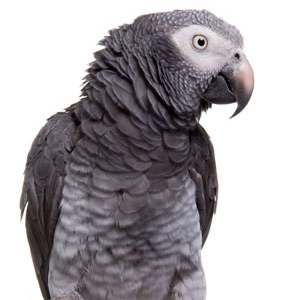
It doesn’t take research to know that getting young children to understand sharing — whether toys, snacks or a favorite book — can be a challenge; just ask any parent! But children do eventually grasp the concept. Interestingly, some research has shown that most children even have a tendency, as they mature, to act so as to avoid inequality.
Sharing seems to be less common in our nonhuman primate relatives, and appears to occur only under some fairly specific conditions. But what about creatures that are not primates? Our recent studies suggest that African grey parrots also can engage in sharing behavior.
Do Parrots Care To Share?
My students and I started looking into this possibility, because sharing in parrots does occur in the wild. In a mated pair, for example, birds often share food or engage in reciprocal preening, and often don’t have to be related to be willing to preen each other. We also know that, in the wild, a single parrot is a dead bird, because it can’t both forage and scan for predators. Thus parrots in flocks engage in sentinel behavior where one bird sits up in a tree on watch for predators while the rest of the flock eats. It may not be on an exact tit-for-tat basis, but they do share that behavior, because one bird is not always going to be the sentinel. The idea is that it may be my turn now, but it’s going to be your turn eventually.
We ran two different experiments to see if African grey parrot Griffin would be willing to share with his human trainers and caretakers. In the first experiment, Griffin and humans, working in dyads (twos), took turns choosing one of four differently colored cups with differing outcomes: empty (null, non-rewarding), selfish (keeping reward for oneself), share (sharing a divisible reward), or giving (donating reward to other). The human dyads involved three different trainers with different specific intentions (selfish, giving, or copying the bird’s behavior). In that situation, Griffin was willing to share a reward with a human who was willing to give up her reward (note that he didn’t simply copy the human and give up his reward, but was willing to share), was selfish with the selfish human, but only tended toward sharing with the copycat human.
We theorized that Griffin’s inability to understand the copycat condition fully — that he could potentially maximize reward by choosing to share — was a consequence of his viewing the copycat’s behavior as erratic compared with the consistently selfish or giving humans and thus not realizing that he was indeed being mirrored. We suggested that copycat trials subsequently be performed as a separate experiment, without being contrasted with trials in which humans acted consistently, in order to determine if results might have differed. We have now performed that experiment, and found that Griffin responded in a manner suggesting that he deduced the appropriate contingencies. This new study also suggests that birds like Griffin are capable of thinking ahead and understanding how their actions in the near term will affect those of their human partners in the future.
Notably, in the first experiment, Griffin wasn’t simply copycatting what the student was doing; he wasn’t being altruistic, as was the student, but was willing to share what might seem like the bonus in the green cup. In effect, he was saying, “If you’re willing to give me something, I’m willing to share with you.” He was clearly maximizing his reward. In the latter experiment, he understood that if he shared now, the student would share next.
Although he didn’t start the second experiment by sharing at a statistically significant rate in the first sessions with both students, over time, he came to understand, at a statistically significant level, that he would indeed get a better payoff by picking the green cup — and sharing the reward. That’s not to say Griffin didn’t occasionally choose the pink cup even late in the experiment (which garnered him the same immediate reward), but he realized that every time he chose pink and got a treat, then on the next round, he didn’t, and thus reverted to sharing. Interestingly, even at the beginning, he rarely chose either the orange or purple cup, seemingly remembering what they represented over the many months that had elapsed between the experiments.
Note that for Griffin to succeed, it was important that we separated out the so-called “copycat” sessions from the others where the students all acted either selfishly or generously. Although he might have eventually understood the linkage between his actions and the copycat student in the first experiment, he certainly had an easier time when the trials were run independently and the contingencies were clearer.
*Special thanks to Peter Reuell, Harvard staff writer for input on this article.
Click this video link to get an insider’s view of Dr. Pepperberg’s lab and meet her grey flock.





